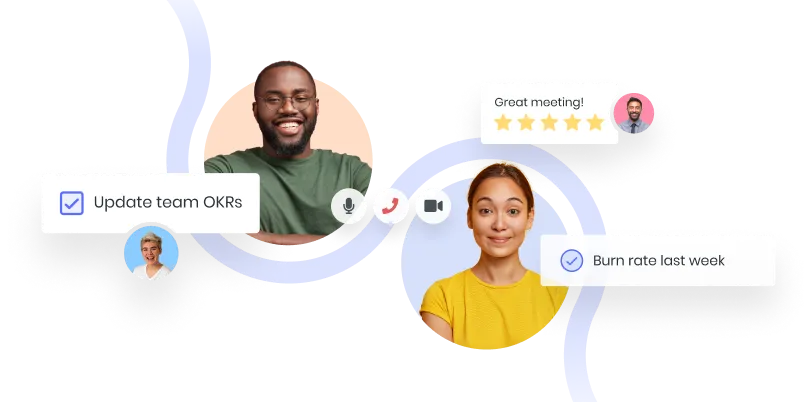.png)

Name
- What did you do yesterday?
- What will you do today?
- Where are you blocked?
- Comfort Level — How close are we to hitting our goals?
Name
- What did you do yesterday?
- What will you do today?
- Where are you blocked?
- Comfort Level — How close are we to hitting our goals?
The point of a stand-up meeting is to quickly provide high-level updates across a project team, and to see if all projects are on track.
You can use this stand-up meeting template for stand-ups of any kind, whether they be a traditional scrum meeting for developers or a quick stand-up meeting for any team. Copy it into a document or use the template right in in Fellow (meeting notes & tasks software).
This sample agenda focuses on answering these four key questions for all who are invited to the stand-up:
- What just happened?
- What is happening next?
- How can the team help you?
- Do we need to recalibrate our estimates?
How to customize this stand-up meeting template?
Depending on how your team likes to run stand-up meetings, the fourth question, “Do we need to recalibrate our estimates,” may not be necessary or appropriate.
In scrum meetings, estimating how long it will take to build and ship features is part of the agile software development process. If a task is beginning to slip outside of its original scope or time estimate, it’s good to be open about these delays early.
But if you’re on a different kind of team, managing time estimates may not be a core part of how you work, in which case you can delete or replace this question in the agenda template.
Optional: For faster stand-ups, write it down
Part of the appeal of the stand-up meeting is its free-form nature. These meetings aren’t supposed to take long.
However, some teams, especially larger ones, prefer to fill in their stand-up meeting agendas with bullet points so that everyone’s updates go extremely quickly. You can read the bullet points out loud, or silently. The small investment in organizing your thoughts in bullet points can save a lot of time for everyone else at the meeting.
Some teams will even skip a real-time meeting entirely and do their stand-ups via a chat app like Slack of Microsoft Teams.
What not to do during stand-up meetings
Standup meetings can be the heartbeat of your work, keeping everybody in sync, but they can also become a waste of time if they become too detailed, or focused on the wrong things. That’s why it’s good to remember that this team meeting is not a problem-solving meeting.
So while this stand-up agenda template may ask you, “How can the team help you?” don’t take this as an invitation to spend 20 minutes detailing out a full plan for help. That comes later. Simply make the request, and agree to connect after the meeting. For example, simply saying “I’m struggling with XYZ, and could use a second pair of eyes” is enough.
If issues come up during the stand-up that need to be addressed immediately, the relevant team members should huddle afterward to figure out a plan, leaving those uninvolved to move on with their work.
Quick! Stand-up meeting best practices
- Keep it short. In a meeting, 15 minutes is the maximum time allotted for conducting a meeting. In order to keep the meeting focused, set the task and begin wrapping up as soon as possible.
- Get down to business. Avoid unnecessary chit chat and dive right into what needs to be discussed at this meeting.
- Get sharp. If team members are not well prepared to engage in the meeting, they are most likely to leave the meeting with a "meh" feeling.
- Avoid distractions. Do not allow things that are not related to the project to distract them during the meeting. These distractions may cause them to lose focus on what is being discussed at hand, which is obviously a bad thing.
- Be strict about time management. No one enjoys meetings that run way past the allotted time because it wastes time and makes other things unachievable.
What kinds of teams have stand-up meetings?
In recent years, the increasing popularity of agile software development practices has led to a surge in teams incorporating a daily stand-up meeting into their host of team meetings. Many types of teams outside of software developers have adopted the stand-up meeting format for their own purposes, including teams of all sizes from small startups to Fortune 500 companies:
- Product teams
- Marketing teams
- Sales teams
- Customer success / service teams
- Team members working together on a short-term project




